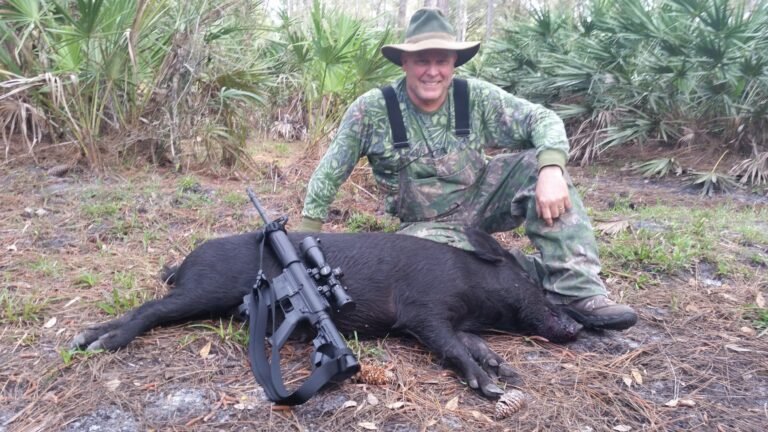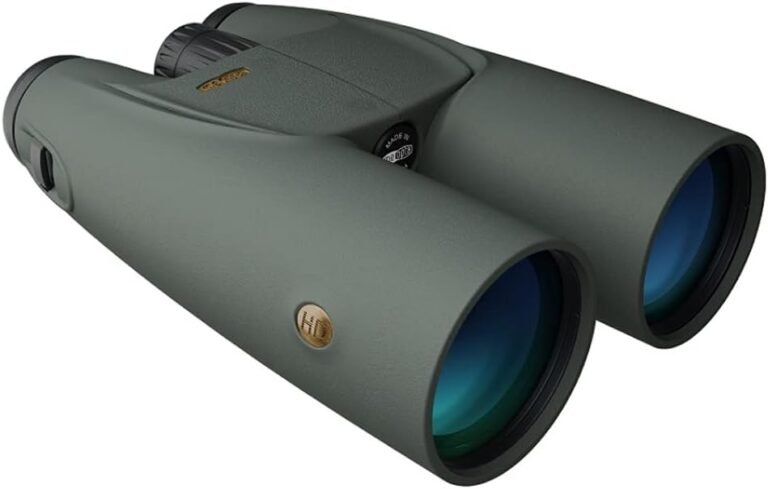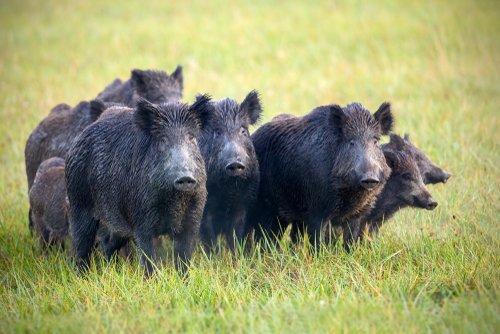Camouflage: Essential Hunting Gear You Must Have Now
When it comes to hunting, one of the essential skills every hunter must possess is the art of camouflage. Camouflage for hunting is key to blending in during hog hunts and concealing oneself in the wild, allowing hunters to get closer to their prey without being detected.
It is a technique that has been honed and perfected over centuries, relying on a combination of clothing, gear, and knowledge of the environment. Camouflage and concealment go hand in hand when it comes to successful hunting.
The goal is simple: to become invisible in plain sight. By disguising ourselves within the natural surroundings, we can disrupt the prey’s ability to recognize us as a threat and increase our chances of a successful hunt.
To achieve effective camouflage for hog hunting, it’s crucial to understand the principles behind this art. The first aspect revolves around color patterns.
Different animals perceive colors differently due to variations in their visual systems. Hence, choosing colors that blend seamlessly with your surroundings becomes paramount.
For example, earthy tones like browns and greens work well in forested areas, while desert camo with sandy hues would be more appropriate for arid terrains. Another vital factor is texture.
Ensuring your clothing and gear mimic nature’s unique textures can significantly enhance camouflage effectiveness. Whether replicating bark on tree stands or mimicking foliage on ghillie suits, attention to detail can make all the difference between being seen and remaining hidden.
Moreover, understanding how light plays into camouflage techniques is crucial. Shadows cast by trees or rocks can reveal your presence if you’re not careful about where you position yourself or how you move through your hunting ground.
You can further minimize detection by utilizing shadows strategically and altering your posture accordingly – avoiding straight lines when possible. Mastering camouflage techniques is vital for hunters seeking success in hog hunts and other wilderness endeavors.
Effective camouflage can distinguish between a rewarding hunt and a missed opportunity, from selecting appropriate colors and textures that merge seamlessly into the environment to harnessing the power of light and shadows. So, gear up, learn about your hunting surroundings, and embrace the art of blending in – for those who truly understand this craft, the wild becomes their ultimate sanctuary.
Camouflage and Concealment
When it comes to hunting, one of the most crucial skills you need to master is camouflage and concealment. The art of blending in seamlessly with your surroundings can make all the difference between a successful hunt and coming home empty-handed.
Whether stalking hogs in densely wooded areas or waiting patiently in a tree stand, understanding camouflage techniques is essential for staying hidden from your prey. First and foremost, choosing the right type of camouflage pattern that suits the terrain you’ll be hunting in is essential.
Different regions have varying vegetation, so selecting a camo pattern that mimics the colors and textures of your surroundings is key. If you’re planning a hog hunt in a forested area with lots of brown leaves and dark underbrush, opt for a pattern incorporating earthy tones like browns, greens, and blacks.
This will help you blend into your environment when concealing yourself among foliage or against tree trunks. Besides selecting appropriate camouflage clothing, attention to details like face paint and accessories that break up your shape is also important.
Animals have keen senses, including sharp vision, so any exposed skin or shiny surfaces can give away your position quickly. Use face paint to cover any exposed skin on your face and neck, matching it with the surrounding colors.
Additionally, consider wearing gloves that match your camo pattern to avoid any reflective surfaces from uncovered hands. Remember that effective concealment goes beyond just wearing camouflaged clothing; it also involves utilizing natural elements in the wild.
When positioning yourself during hog hunts, take advantage of natural cover such as bushes or fallen logs. By positioning yourself strategically behind these obstacles while maintaining good shooting angles, you can effectively conceal yourself while still having a clear line of sight for taking down unsuspecting hogs.
Mastering camouflage techniques is an ongoing process that requires observation skills and adaptability. Always be mindful of your environment and adjust your camouflage accordingly.
By concealing in the wild and blending in seamlessly during hog hunts, you’ll increase your chances of a successful hunt while experiencing the thrill of outsmarting your prey. So, take the time to study your terrain and invest in quality camouflage gear – it’s an investment that will pay off when you’re stalking through the woods like a true hunter.
Camouflage Essentials for Hog Hunting
When it comes to hog hunting, blending in with your surroundings is crucial. Hogs have a keen sense of smell and remarkable eyesight, so investing in the right camouflage gear is necessary.
The first essential item is a high-quality camo pattern that matches the terrain you’ll be hunting in. Opt for patterns that mimic the colors and textures of the local foliage, such as mossy oak or realtree designs.
These patterns help break up your outline and make you less visible to hogs. In addition to camo clothing, investing in face masks or paint can greatly enhance your concealment during hog hunts.
Hogs are particularly wise when spotting movement and can easily detect an exposed face amidst the underbrush. Apply camouflage face paint or wear a mask matching your camo pattern, ensuring no bare skin is left uncovered.
Take special care around areas like your nose and ears, which appear more prominently. Another essential aspect of hog hunting camouflage is scent control.
Hogs have an incredible sense of smell, which they use to detect predators like humans from great distances. Using scent-eliminating products like sprays or laundry detergents designed specifically for hunting can significantly reduce human odor and increase your chances of remaining undetected by hogs.
Storing your hunting clothes in scent-free bags or containers will help retain their effectiveness over time. Regarding hog hunting, remember that blending into your surroundings is paramount for success.
Invest in high-quality camo clothing with patterns that match the local terrain, use face masks or paint to hide any exposed skin, and prioritize scent control through specialized products designed for hunters. Equipping yourself with these essential camouflage tools and techniques will maximize your ability to conceal yourself effectively during hog hunts and increase your chances of a successful hunt. undefined
Camo Clothing and Gear for Hog Hunts
Regarding hog hunting, having the right camouflage clothing and gear can make all the difference. Not only does it allow you to blend in seamlessly with your surroundings, but it also helps you become virtually invisible to the sharp eyesight of hogs.
Let’s look at some essential camo clothing and gear for hog hunts. First and foremost, investing in a good quality camouflage jacket and pants is crucial.
Opt for patterns that mimic the natural colors found in the wild, such as browns, greens, and tans. These earthy tones help you blend into your environment by mimicking the colors of trees, foliage, and dirt.
Additionally, consider purchasing camo clothing with a scent-control feature to further enhance your stealthiness during hog hunts. Another important piece of camo gear is a face mask or face paint.
Hogs have an acute sense of smell but relatively poor eyesight, so ensuring your face is properly concealed can greatly increase your chances of success. A lightweight face mask or applying camouflage face paint not only hides any exposed skin but also prevents unwanted reflections that might alert nearby hogs to your presence.
In addition to clothing and face concealment, other accessories can enhance your camouflaging capabilities during hog hunts. One such item is a ghillie suit—a camouflage garment covered in strips of fabric or netting designed to resemble natural vegetation.
Ghillie suits are particularly effective when hunting in dense brush or grassy areas, breaking up the human silhouette and providing exceptional concealment. Remember, when choosing camo clothing and gear for hog hunts, it’s essential to consider functionality and practicality.
Select items comfortable enough for long hours spent outdoors while effectively concealing you from wary hogs. Investing in high-quality camouflage clothing such as jackets, pants, face masks, or paint, and accessories like ghillie suits will maximize your concealment in the wild and increase your chances of a successful hog hunt.
Natural Camouflage: Using the Environment to Your Advantage
When it comes to hunting, one of the most effective strategies for blending in and staying concealed is to use natural camouflage. Mother Nature has provided abundant resources to help us disappear into our surroundings and increase our chances of a successful hunt.
By understanding how to utilize the environment to our advantage, we can become virtually invisible to our prey. One of the first things you must consider when using natural camouflage is the season and terrain you’ll be hunting.
Different seasons bring different colors, so selecting clothing and gear that match the predominant hues in your hunting area is crucial. For example, when leaves turn shades of brown and orange in autumn, opt for camo patterns that mimic these colors.
Choose earth tones like brown and green in a dense forest to blend seamlessly with the surroundings. By selecting appropriate attire based on the environment, you’re already taking a significant step towards concealing yourself effectively.
In addition to choosing appropriate clothing, it’s essential to understand how animals perceive their environment. Animals rely heavily on their ability to detect movement rather than static objects alone.
Therefore, as a hunter utilizing natural camouflage, it’s crucial for you not only to blend in visually but also minimize any unnecessary movements that could alert your target prey. Moving slowly and deliberately while keeping a keen eye out for any animals nearby will greatly increase your chances of remaining undetected.
Natural camouflage isn’t just about wearing the right gear or moving cautiously; it also involves utilizing natural cover effectively during your hunt. Take advantage of trees, bushes, or other available foliage that can break up your silhouette or provide additional concealment.
Position yourself strategically behind these natural barriers while watching your surroundings for any signs of movement or approaching game animals. Understanding how nature works and employing this knowledge effectively during your hunts can significantly enhance your camouflage skills.
Utilizing appropriate attire based on seasonal colors, minimizing movement, and using natural cover to your advantage will make you virtually invisible to your prey. So, get out there, embrace the environment, and let Mother Nature be your ally on your hunting adventures.

Advanced Camouflage Strategies
Blending in with your surroundings can give you that extra edge in hunting. It can take your concealment game to the next level, making you practically invisible in the wild.
Let’s explore a few techniques that experienced hunters swear by. One effective advanced strategy is the use of 3D camouflage.
This camouflage clothing is designed to mimic the depth and texture found in nature, allowing you to blend seamlessly into your environment. With its realistic foliage patterns and lifelike coloration, 3D camouflage can make you virtually disappear among trees, bushes, and grasses.
Coupled with careful movements and a keen eye for detail, this strategy can greatly increase your chances of getting close to hogs without being detected. Another tactic that hunters employ is known as contour breaking.
This technique involves disrupting the outline of your body or gear by strategically placing natural elements, such as branches or leaves, on your clothing or equipment. By breaking up solid shapes and incorporating surroundings directly onto yourself, you create an illusion that makes it difficult for hogs to recognize you as a threat.
Whether attaching foliage to your hat or using fabric loops for easy attachment of plant matter, contour breaking helps ensure maximum concealment during hog hunts. Furthermore, understanding light and shadow is crucial in advanced camouflage strategies.
Shadows cast by trees or other objects can reveal your presence if not carefully managed. Experienced hunters use this knowledge by strategically positioning themselves so that their silhouette merges with existing shadows or remains hidden behind obstacles like fallen logs or rock formations.
By mastering this skill, hunters can move undetected through dense terrain during daytime hunts while minimizing their chances of being noticed by sharp-eyed prey. Advanced camouflage strategies provide hunters with valuable tools for concealing themselves effectively in the wild during hog hunts.
Whether utilizing 3D camo garments for optimal blending into natural surroundings, employing contour-breaking techniques to break up your silhouette, or mastering the art of utilizing shadows and light, these strategies can greatly enhance your hunting experience. Remember, being invisible to hogs is the key to a successful hunt, and investing in advanced camouflage techniques will undoubtedly tip the scales in your favor.
Conclusion
Mastering the art of camouflage is essential for successful hunting trips, especially when it comes to hog hunts. Throughout this article, we have delved into various aspects of camouflage and concealment, exploring the importance of proper camo clothing and gear and utilizing natural elements to blend seamlessly into the environment.
When it comes to hog hunting, concealing in the wild is crucial. Hogs have acute senses that make them incredibly alert to any human presence.
Investing in quality camo clothing that matches your surroundings and using gear that helps break up your silhouette can significantly increase your chances of going unnoticed by these intelligent creatures. Remember to pay attention to small details like choosing a camo pattern that matches the environment you’ll be hunting in – whether it’s dense woodland or open fields.
Blending in during hog hunts also means taking advantage of natural camouflage provided by Mother Nature herself. Use surrounding foliage to create effective hiding spots, or incorporate elements like branches and leaves into your attire.
Understanding hog behavior and their preferred habitats can further enhance your ability to remain concealed during hunting expeditions. Honing your camouflage skills will increase your chances of success and provide a deeper connection with nature.
The thrill of outsmarting game animals through effective concealment adds an element of excitement to every hunt. So embrace the challenge and take pride in perfecting this ancient art form – remember that with practice and attention to detail, you, too, can become a master at blending seamlessly into the wilds during your hog hunts!





